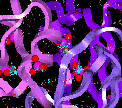 Molecular Dynamics -
Pressure and Stress
Molecular Dynamics -
Pressure and Stress Molecular Dynamics -
Pressure and Stress
Molecular Dynamics -
Pressure and Stress
In an isotropic situation, where forces are the same in all directions and there is no viscous force, the pressure tensor is diagonal. With the same diagonal elements, the tensor can be written as:
Sometimes, (especially in materials science studies), the pressure tensor is also referred to as the stress tensor or simply the stress. The diagonal elements are known as the tensile stress, and the non-diagonal elements are the shear stress.
Since the Discover 2.9.5 program is geared towards controlling pressure, the unit used is bar. In the Discover 95.0 program, constant-stress dynamics has GPa as the default unit.
Also note that pressure and stress, although defined in the same physical quantities, have different sign conventions. Positive pressure implies a compressive force pushing the system inward, but positive stress means a force acting outward to pull the system apart.
Thermodynamic pressure, thermodynamic temperature, volume, and internal virial can be related in the following way:
Analogous to the temperature, an instantaneous pressure function P can be defined so that thermodynamic pressure is the average of the instantaneous values:
When periodic boundary conditions are used, atoms in the unit cell interact not only with the other atoms in the unit cell but also with their translated images. Forces on the images in the virial W must be included correctly, especially for implicit images. If the interaction is pairwise, using Newton's third law, W can be written as:
The Discover program, however, calculates pressure on the atomic basis and performs atomic scaling. The major advantage of using atomic scaling of the coordinates is that atom overlapping can be avoided. Such overlap can occur if centers of mass are moved instead of individual atoms. In addition, for large molecules having internal flexibility, atomic scaling has been found to yield a smoother response to pressure changes.
Because the Discover program uses explicit images (also called ghost atoms) in periodic boundary conditions, the rij · fij formalism is used with ghost atoms (explicit images) included. When the option of using the minimum image (implicit image) is used under periodic boundary conditions, the formalism of rij · fij is used so that forces between real and image (ghost) atoms can be properly accounted for.
During a molecular dynamics simulation, the Discover program
uses Berendsen's method (Berendsen et al. 1984), which
couples the system to a pressure ``bath'' to maintain the pressure at
a certain target. The strength of coupling is determined both by the
compressibility of the system (using a user-defined variable ) and by a relaxation time constant (a
user-defined variable
). At each step, the
x, y, and z coordinates of each atom are scaled
by the factor:
Note that this method changes the cell uniformly, so that the size of the cell is changed, but not its shape. In cases such as phase transitions of crystals, where both the cell size and shape are expected to change, this method is not appropriate.
The pressure fluctuation has been observed to be large during test runs with the Discover program and in other studies in the literature (Brown and Clark 1984). Negative pressures sometimes occur because the virial can be negative, even though this defies the usual sense that pressure is a positive number. The calculated pressure depends on the cutoff distances used in the simulation. To compensate for the missing long-range part of the potential contributions to the energy, pressure at r > rc can be estimated by assuming the radial distribution g(r) ~ 1 (uniform distribution) in that region. With this assumption and the known form of nonbond potentials, the correction can be estimated analytically (Allen and Tildesley 1987). However, this correction is not built into the calculation. If the cutoff distance is too short, the calculated pressure may be wrong. Therefore in practice, you should test the effect of cutoff on pressure by gradually increasing the cutoff and choosing the appropriate cutoff accordingly.
The basic idea of the method is to treat the volume V of the cell as a dynamic variable in the system. The Lagrangian of the system is modified so that it contains a term in the kinetic energy with a user-defined mass M and a potential term which is the pV potential derived from an external pressure Pext acting on volume V of the system.
The method was presented in detail by Parrinello and Rahman (1981)
and is only summarized here. The Lagrangians of the system are
modified such that a term representing the kinetic energy of the cell
depends on a user-defined mass W. An elastic energy term
p is related to the pressure and
volume or the stress and strain of the system. The equations of motion
for the atoms and cell vectors can be derived from this
Lagrangian. The motion of the cell vectors, which determines the cell
shape and size, is driven by the difference between the target and
internal stress.
With hydrostatic pressure only:
With stress, the elastic term p is
replaced by:
Note the user-defined variable W. A large W means a heavy, slow cell. In the limiting case, infinite W reverts to constant-volume dynamics. A small W means fast motion of the cell vectors. Although that may mean that the target stress can be reached faster, there may not be enough time for equilibration. In tests, too small a W also induced artificial periodic motions of the cell. A value of 20 seems to give satisfactory results for a cell with 76mers of polyethylene, and hence is used as the default value for W.
 Main
access page
Main
access page  Theory/Methodology access.
Theory/Methodology access.
 Dynamics access
Dynamics access
 Dynamics - Temperature
Dynamics - Temperature
 Dynamics - Constraints
Dynamics - Constraints
Copyright Biosym/MSI